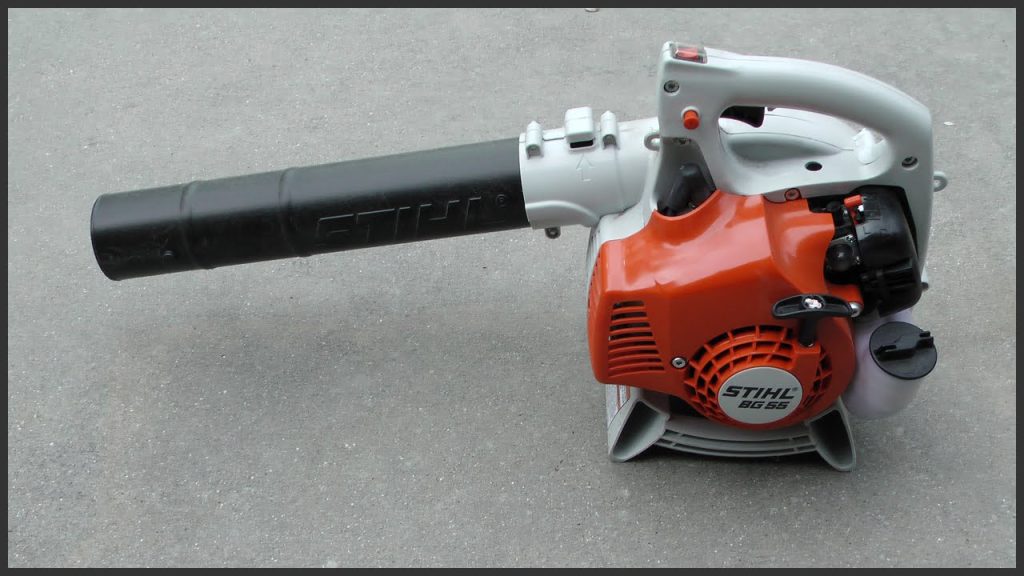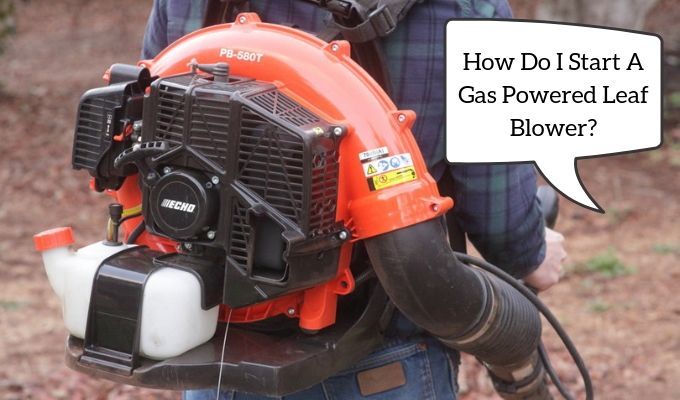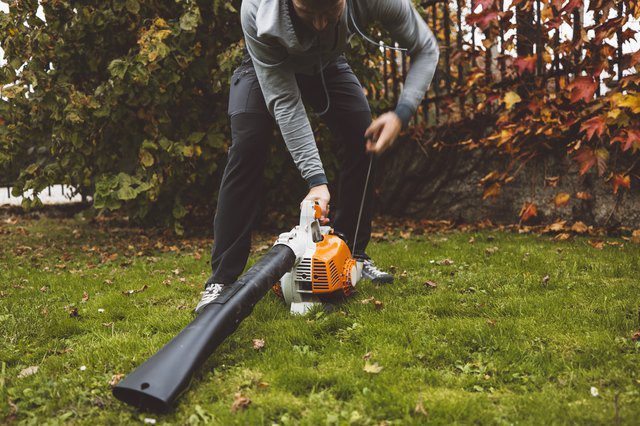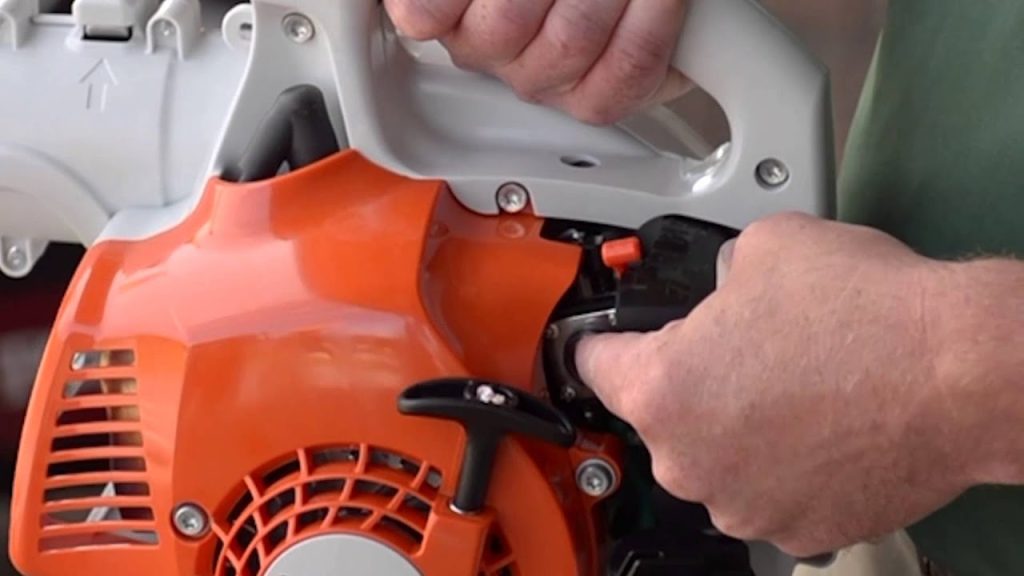Starting a gas leaf blower may seem daunting, especially if you’re new to yard maintenance. However, fear not because we’re here to walk you through the process step by step.
From ensuring you have the correct fuel mixture to properly priming the engine and gently pulling the recoil starter, we’ll guide you towards effortlessly starting your gas leaf blower in no time.
So, let’s get started and make your outdoor cleanup a breeze!
This image is the property of i.ytimg.com.
Safety Precautions
Wear Safety Gear
When using a gas leaf blower, it is essential to prioritize safety. We should always wear the appropriate safety gear to protect ourselves from harm. This includes wearing safety goggles to shield our eyes from debris, ear protection to minimize noise, and gloves to ensure a secure grip on the blower. Additionally, wearing sturdy footwear and long pants is crucial to safeguard our legs and feet from flying debris.
Choose a Safe Working Area
Before starting the gas leaf blower, we must carefully select a safe working area. It is advisable to clear the area from obstacles, such as stones, branches, or toys, as they can be hazardous if caught in the blower’s airflow. Furthermore, we should ensure that there are no bystanders, pets, or children within the immediate vicinity of our working area. This will help prevent accidents or injuries and create a safer environment for everyone.
Check the Weather Conditions
It is essential to check the weather conditions before using a gas leaf blower. Strong winds or adverse weather conditions can make it difficult to operate the blower efficiently and may even pose risks such as debris being blown back towards us.
Therefore, avoiding using the blower during windy or rainy weather is wise. By being aware of the weather conditions, we can ensure a safer and more comfortable experience when operating the gas leaf blower.
Inspecting the Equipment
Check the Gas Level
Before starting the gas leaf blower, inspecting the fuel level in the gas tank is essential. We should ensure that there is an adequate amount of fuel to operate the blower effectively. Filling the tank with the appropriate gasoline-oil mixture is recommended if the fuel is low, as the blower’s user manual specifies. It is crucial to follow the manufacturer’s instructions to avoid damage to the engine and ensure optimum performance.
Inspect the Air Filter
The air filter plays a vital role in maintaining the performance of a gas leaf blower. Therefore, it is essential to regularly inspect the air filter and clean or replace it as necessary. A clogged or dirty air filter can hinder the airflow, reduce the blower’s efficiency, and potentially damage the engine. By keeping the air filter clean, we can ensure the proper functioning of the blower while preventing unnecessary dirt or debris from entering the engine.
Inspect the Spark Plug
Checking the spark plug is another crucial step before starting a gas leaf blower. A worn-out or dirty spark plug can lead to difficulty starting the engine and cause poor overall performance. To inspect the spark plug, we should remove it from the engine and examine its condition.
If there is excessive wear or carbon buildup, replacing the spark plug with a new one may be necessary. By keeping a well-maintained spark plug, we can ensure a smoother and more reliable leaf blower operation.
Priming the Engine
Locate the Primer Bulb
To prime the engine of a gas leaf blower, we must first locate the primer bulb. The primer bulb is usually a small rubber bulb located on the side of the blower’s engine. It aims to draw fuel into the carburetor, ensuring a more leisurely start.
Press the Primer Bulb
Once we have located the primer bulb, we must press it several times to prime the engine. Typically, pressing the primer bulb 3 to 5 times is sufficient. This action helps to fill the carburetor with fuel, ensuring a smoother start and minimizing the number of pulls required to start the engine.
Setting the Controls
Set the Choke
Setting the choke correctly is crucial for starting a gas leaf blower. The choke is a control that regulates the air and fuel mixture during the engine’s startup. To set the choke, we usually need to move the choke lever or switch to the “choke” or “start” position. This position allows for a richer fuel mixture, aiding the engine’s cold start.
Set the Throttle
The throttle control regulates the engine’s speed and airflow during operation. Before starting the gas leaf blower, we should set the throttle to the appropriate position, usually marked as “start” or “idle.” This will ensure that the engine starts smoothly without overwhelming it with excessive power. By setting the throttle correctly, we can maintain control and prevent any potential accidents or damage.
This image is the property of bettertoolz.com.
Starting the Engine
Place the Blower on the Ground
We should securely place the gas leaf blower on the ground to start the engine. Ensuring the blower is stable and adequately balanced will prevent accidental tipping or movement while starting the engine. Keeping the blower away from flammable materials is also essential to avoid fire hazards.
Engage the On/Off Switch
Before pulling the starter rope, we must ensure the blower’s on/off switch is in the “on” position. This switch controls the flow of power to the engine. By engaging the on/off switch, we provide electricity to the spark plug and enable the engine to ignite the fuel-air mixture when we pull the starter rope.
Pull the Starter Rope
With the blower on the ground and the on/off switch engaged, we can start the engine by pulling the starter rope. A firm but smooth pull is generally required to initiate the engine’s startup. Starting the engine may take a few attempts, especially if it is cold. Once the engine starts, we can move on to the next phase of running and operating the gas leaf blower.
Running and Operating
Warm Up the Engine
After successfully starting the engine, allowing it to warm up for a few minutes before operating the blower is essential. This warm-up period helps ensure proper functioning and optimal performance of the gas leaf blower. We should listen for any unusual noises or vibrations during this time and address them promptly if necessary.
Control the Airflow
Controlling the airflow is crucial when using a gas leaf blower. Depending on the task, we can adjust the blower’s airspeed and direction to achieve the desired result. It is important to remember that using a higher airspeed may not always be the most effective or efficient choice. By finding the right balance and adjusting the airflow, we can efficiently clear leaves, debris, or grass clippings without causing unnecessary disturbance or damage.
Avoid Overheating
During prolonged usage, keeping an eye on the blower’s engine temperature and preventing overheating is essential. Overheating can lead to engine damage and affect the blower’s performance. We should periodically check the engine temperature and pause the operation if it becomes boiling to avoid this. Allowing the blower to cool down before resuming work will help maintain a safe operating temperature and extend the longevity of the gas leaf blower.
This image is the property of img.hunkercdn.com.
Shutting Down
Release the Throttle
When our gas leaf blower has served its purpose or requires a temporary break, it is essential to release the throttle. Releasing the throttle control will return the engine to an idle state and prevent any potential accidents during shutdown. We can gradually reduce the engine’s speed and airflow to ensure a controlled and safe shutdown process.
Turn off the Engine
To completely shut down the gas leaf blower, we should turn off the engine using the on/off switch. This action cuts off the power supply to the spark plug and stops the engine from running. It is crucial to wait for the engine to come to a complete stop before moving on to the final step of storing the blower safely.
Store the Blower Safely
Once the engine is off, we need to store the gas leaf blower safely and responsibly. This includes cleaning off debris or dirt from the blower’s exterior, air vents, and cooling fins. We should also inspect the fuel tank and ensure it is empty or adequately sealed to prevent any potential leaks. Storing the blower in a dry, well-ventilated area away from flammable materials will help maintain its longevity and ensure its readiness for future use.
Maintenance and Troubleshooting
Regular Cleaning
Regular cleaning is essential to keep our gas leaf blower in optimal condition. This includes removing debris, dirt, or grass clippings from the blower’s air vents, cooling fins, and various components. Additionally, we should clean or replace the air filter regularly to maintain proper airflow and prevent dust or debris from entering the engine. Regular cleaning in our maintenance routine can prolong the blower’s lifespan and maintain efficiency.
Inspecting and Replacing Parts
Periodic inspection of the gas leaf blower’s parts is crucial for identifying signs of wear or damage. We should pay particular attention to components such as the spark plug, fuel lines, and carburetor. Any damaged, worn-out, or malfunctioning parts should be promptly replaced. Regular maintenance and replacement of worn-out parts will help ensure the gas leaf blower’s reliability and prevent unexpected breakdowns.
Common Issues and Solutions
Like any other machinery, gas leaf blowers may encounter common issues during operation. These can include difficulty starting the engine, poor performance, or excessive smoke.
If we encounter any of these problems, we must refer to the blower’s user manual or seek professional assistance. Troubleshooting may involve checking the fuel mixture ratio, cleaning the carburetor, or adjusting the spark plug gap. By understanding common issues and their solutions, we can quickly address any problems and get our gas leaf blower back in working order.
In conclusion, starting and operating a gas leaf blower involves several steps to ensure safety and efficiency.
By following the appropriate precautions, inspecting the equipment, priming the engine, setting the controls, starting and running the engine, and properly shutting down the blower, we can safely and effectively use a gas leaf blower to clear leaves, debris, and other unwanted materials.
Additionally, practicing regular maintenance and troubleshooting common issues will help maintain the blower’s performance and extend its lifespan. With these guidelines, we can confidently start and operate a gas leaf blower for a cleaner and more manicured outdoor space.
This image is the property of i.ytimg.com.







































